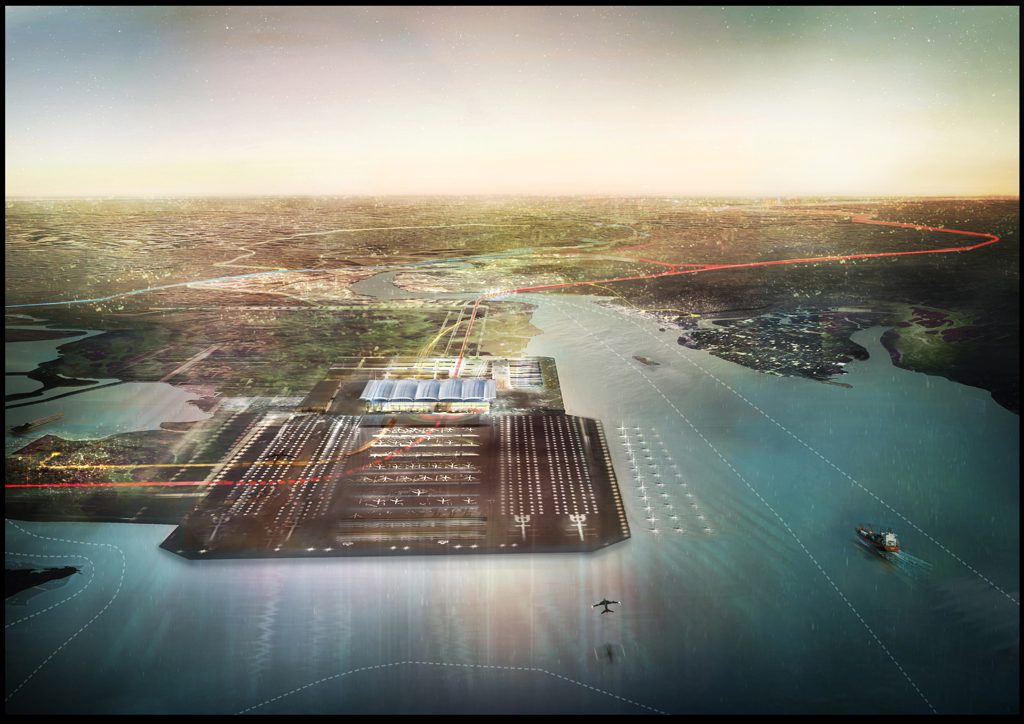First it seemed all just a distraction from the failed third runway expansion for London Heathrow but more recently, the concept of an entirely new airport located in the Thames estuary is gaining momentum. This is the time for us to investigate and report on this idea in more detail.
Let’s start by asking where we think the United Kingdom is heading towards with its long-term transportation planning? Well, this is a loaded question, so we’re passing it over to Boris Johnson, London’s Mayor was recently quoted saying that without a new hub airport the country faces economic starvation.
In this case by hub Boris Johnson mean the proposed airport in the Thames Estuary, the area in England’s southeast where the River Thames meets the waters of the North Sea. Planning to build an airport there isn’t exactly a new idea as several sites have come up in the past. Wikipedia informs us that in the 1960s Maplin Sands was a contender; in 2002 it was to be at Cliffe, Kent. This time the new airport would be built on a man-made island in the estuary north of Minster-in-Sheppey.
So why getting back to an old concept? London has five commercial airports of which Heathrow (IATA: LHR) and Gatwick (IATA: LGW) are the main ones, but with 66 Million passengers last year, Heathrow is the big one. The problem is it can’t grow further within its existing facilities as it already runs at 98% capacity. The quickest solution – you would think – is to upgrade the airport and add -let’s say – a 3rd runway. Well – surprise, surprise – this is exactly what has been tried but seems to be without chances with the current government at this time.
In the Financial Times Ashley Steel of KPMG said the chancellor’s opposition to a third runway at Heathrow was “disappointing”. “It means we will have to wait 15 to 20 years for new airport capacity and much needed links to China, Brazil and other growing economies,” she added. Surely such a delay could proove very costly for the Kingdom’s economy as other European airports like Frankfurt (IATA: FRA) or Amsterdam Schiphol (IATA: AMS) are already expanding their capacities.
But it’s not necessarily all that dark and gloomy as Gatwick is still a development possibility, especially after the previous owner, BAA was forced to sell it. The airport is making a lot of progress in upgrading its outdated infrastructure and facilities and so far the government hasn’t excluded the possibility of a Gatwick expansion. George Osborne, the UK chancellor said “all options for improving airport capacity in the UK’s south east, with the exception of building a third runway at London Heathrow, will be explored by the government”.
In favour of waiting it out and building an entirely new airport is London’s Mayor Boris Johnson who supports Lord Foster’s vision of a multifunctional hub in the Thames estuary. The famous architect’s bid includes a £20bn high-speed Orbital Rail line around London; a new £6bn Thames Barrier and crossing; and a £20bn international Estuary Airport, with annual capacity for 150 million passengers.
Previous bids failed on claims the construction would damage a valuable ecological habitat. Foster and Partners have thought about this and respond that the proposal includes a detailed study of wildlife habitats in the Thames Estuary, investigating the potential for a new nature reserve; analysis of the wreck of the SS Richard Montgomery, a World War II munitions ship, which lies close to the proposed airport site; a survey of the settlements and listed buildings on the Isle of Grain; further detail on rail alignment and integration of utilities and gas insulated cables; and possible locations of intermodal stations on the Orbital Rail link.
A second strong concern is the possible increased risk of bird strikes in the Thames Estuary – but here the architect’s office provides findings which indicate that this problem is not unique to the site and many precedents exist for dealing with this.
With the PR machine now in full swing – Foster and Partners even produced a video to showcase their bid (see below) – the case for this mega project is gaining momentum. And if nothing else, it creates a strongly needed political discussion and for once forces politicians to forward think in order to keep Britain an important economic power within Europe. Which airport strategy supports this best remains to be seen.
[Pictures and videos copyright Fosters and Partners]


One thought on “The Thames hub and what it’s all about”
Comments are closed.